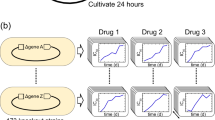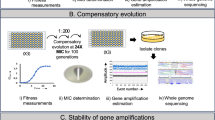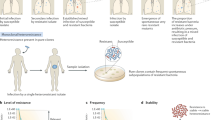Abstract
THE development of populations of bacteria showing increased resistance to drugs is usually assumed to be the result of : (1) a continuous increase in resistance as a result of interaction between drug and cell1, that is, adaptation, or (2) a discontinuous increase due to selection of a few resistant cells either already present2 or induced by the drug3, that is, spontaneous or induced mutation.
This is a preview of subscription content, access via your institution
Access options
Subscribe to this journal
Receive 51 print issues and online access
$199.00 per year
only $3.90 per issue
Buy this article
- Purchase on Springer Link
- Instant access to full article PDF
Prices may be subject to local taxes which are calculated during checkout
Similar content being viewed by others
References
Hinshelwood, C. N., “Selective Toxicity and Antibiotics”, 243 (Cambridge University Press, 1948).
Oakberg, E. F., and Luria, S. E., Genetics, 32, 249 (1947).
Linz, R., Martin, L., and Lecocq, Mme. E., C.R. Soc. Biol., 143, 728 (1949).
Author information
Authors and Affiliations
Rights and permissions
About this article
Cite this article
GIBSON, M., GIBSON, F. Development of Resistance to Dihydrostreptomycin by Bacterium coli. Nature 167, 113–114 (1951). https://doi.org/10.1038/167113b0
Issue Date:
DOI: https://doi.org/10.1038/167113b0
This article is cited by
-
Untersuchungen �ber UV-Resistenz bei Saccharomyces cerevisiae
Archiv f�r Mikrobiologie (1958)
-
Physiological studies on the actinomycetes
The Botanical Review (1953)
Comments
By submitting a comment you agree to abide by our Terms and Community Guidelines. If you find something abusive or that does not comply with our terms or guidelines please flag it as inappropriate.



